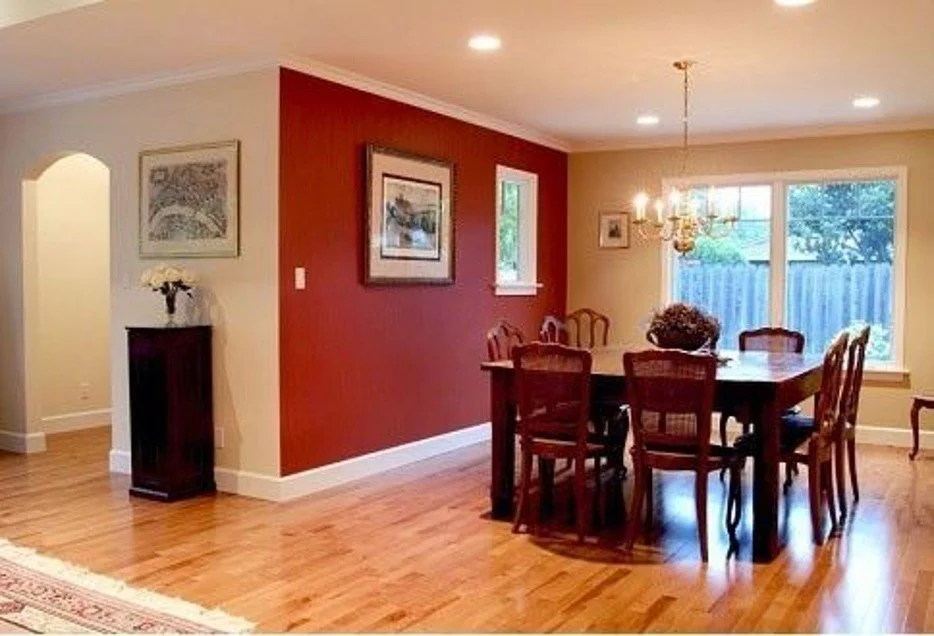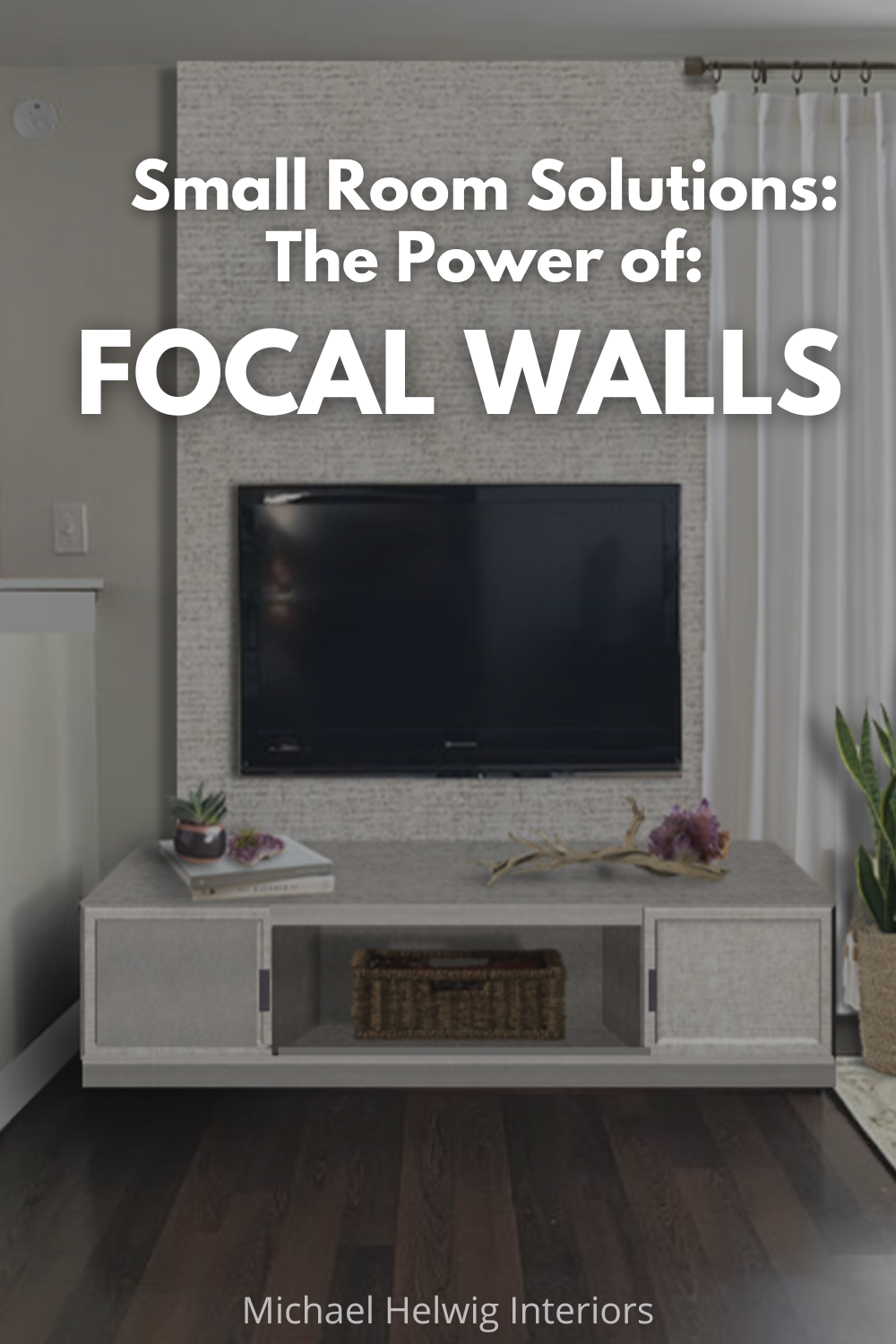As someone who has spent countless hours scrolling through Pinterest and home decor websites, I understand the appeal of a statement wall. It's a great way to add personality to a room and make it stand out.
However, I've noticed that there's some confusion around the terms "focal wall" and "accent wall." While they may seem interchangeable, there are actually some key differences between the two.
So, here’s my take on the differences between accent walls and focal walls. Hint: Based on the title, I’m sure you’re sensing that I’ll be taking a stand on one over the other.
Let’s get into small room solutions: the power of focal walls.
What is a Focal Wall?
A focal wall is a wall that naturally draws your eye to it. It's often the first thing you notice when you enter a room.
Max Rahubovskiy
Focal walls are created by highlighting a feature of the room, like a fireplace, a large piece of artwork, or a window with a beautiful view.
The goal is to create a sense of balance and harmony by emphasizing one element of the space.
Max Rahubovskiy
Focal walls can also be emphasized in different ways. You could have a fireplace wall with built-in shelving all around, or a fireplace wall, where the entire wall is encased in masonry or stonework. The point is a focal wall draws your focus and enhances what it is that you’re looking at in a room.
What is an Accent Wall?
An accent wall, on the other hand, is a wall that is painted or decorated in a way that’s different from the other walls in the room.
Max Rahubovskiy
It's meant to add contrast and break up the monotony of a single color or pattern. Accent walls can be created using paint, wallpaper, wood paneling, or even tile.
Years ago, you may have remembered the bold accent walls that people painted to spice up a room.
Folks would paint a bold red wall in the dining room, or they’d add color or texture to one wall in a bedroom, thinking it would add drama and personality to the space.
However, what usually happened is it actually overwhelmed the room and made it feel disjointed. When you think about it that way, an accent wall can easily become too much of a focal point, taking away from other important elements of the room.
When you think back to those accent walls of the 1990’s, they didn’t really have a context for why the wall should be a different color. And that’s the main difference between accent walls and focal walls:
Focal walls enhance, accent walls contrast.
These days, especially in small rooms, it’s important to keep things more consistent.
A bold colorful wall that doesn’t have context for being bold and colorful doesn’t do anything for the interest or visual flow of your room.
Max Rahubovskiy
But a bold wallpaper in a niche wall - that happens to be the perfect place for a television credenza or entertainment unit in your living room- is a natural draw that’s enhanced by an attention-grabbing wallpaper.
How to Decide Between a Focal Wall and an Accent Wall
When you’re deciding between a focal wall and an accent wall, here are a few key factors to consider:
Max Rahubovskiy
First, think about the natural features of the room. Is there a fireplace, a large window, or a unique architectural detail that you want to highlight? If so, a focal wall may be the way to go.
If there isn't a natural focal point in the room, you can create one to add visual interest without overwhelming the space.
In my house I’m planning a focal wall where my TV unit is.
Now, I don’t have a “natural” focal point in my living room. No big, gorgeous window, no fireplace. I do have this smallish area where the TV is that serves as my focal point.
Michael Helwig
My plan is to enhance the area by extending a faux wall from the floor to the ceiling to create a bump-in that will become my focal point in the room. (When I do that, you’ll be the first to see it, so keep checking back.) So, since this space is where my attention is focused, it is the perfect spot for some definition.
Max Rahubovskiy
Keep in mind that a bold or busy pattern may be better suited for a smaller room, while a neutral or subtle pattern may work well in a larger space. Small rooms process bold pops color or pattern better than larger rooms.
Finally, consider the purpose of the room.
If it's a space where you want to relax and unwind, a focal wall that highlights a natural feature may create a calming atmosphere.
Ksenia Chernaya
If it's a space where you want to be creative or energized, an accent wall may provide the visual stimulation you need. For example, accent walls could work great in playroom spaces where you want to encourage the kids to be creative.
To sum up, the difference between focal walls and accent walls lies in their purpose and design approach.
Focal walls are intended to create a striking centerpiece in a room, drawing the eye and showcasing your personal style. They enhance in a purposeful way.
Max Rahubovskiy
Accent walls can work great for rooms that you want to be energetic and creative in. Spaces like a child’s playroom, a home gym, an art studio space. Accent walls add contrast in a playful way.
Li Sun
A well-designed focal wall can add personality and style without overwhelming the space, while an accent wall that’s too bold, in a room where you want to be calm, can make it feel unbalanced and disjointed.
Ultimately, the decision to use a focal wall or accent wall comes down to personal preference and the specific needs of your space. Whatever you choose, make sure it reflects your unique style and personality and enhances the overall look and feel of your room.
Read Next:
Spice Up Your Space: A Guide To Choosing Art For Your Home
Looking to add some personality to your home with art? Check out this guide on choosing art for your home. From finding an inspiration piece to creating a mood board layout, I've got you covered with tips and tricks to make the process easier. Start exploring the world of art and transform your space today!
Join the Fun!
If you enjoyed this post and you want to keep seeing my weekly blog, the best way to do that is to subscribe.
You can subscribe by downloading my 11 Secrets Only Designers Know to Make Your Space Rock. If you’re curious about how decorators and designers make a home look magazine ready, you’ll love taking a gander at these 11 secrets. You’ll learn how to style your room from the floor up and it will work for ANY space you have.
I write about small space design and decorating, sustainable furniture options, positive self care and a variety of do-it-yourself home décor.
I’d love to connect with you!
“Michael Helwig was top-notch, very professional and responsive to my needs. He allowed me time to explore ideas and try out a variety of combinations until we found the perfect fit. Michael provided detailed information and offered beautiful ideas to make my dream living room become a reality. The furniture he sourced has totally transformed my living room space. Everyone that has seen my new living room has one word, WOW! A special thank you to Michael for a wonderful experience.”
“Michael was very knowledgeable and guided us, with great patience and good humor, through the process of designing our dining room and helping us find the perfect sleeper sofa. He offered really helpful advice when we asked questions - which was often - but at no time did we ever feel pushed. He helped me when I felt like I couldn’t make one more decision. When my new furniture finally arrived I realized everything down to the pillows was perfect. I couldn’t be happier!”
Michael is Principal designer and blogger at Michael Helwig Interiors in beautiful Buffalo, New York. Since 2011, he’s a space planning expert, offering online interior e-design services for folks living in small homes, or for those with awkward and tricky layouts. He’s a frequent expert contributor to many National media publications and news outlets on topics related to decorating, interior design, diy projects, and more. Michael happily shares his experience to help folks avoid expensive mistakes and decorating disappointments. You can follow him on Pinterest, Instagram and Facebook @interiorsmh.




















